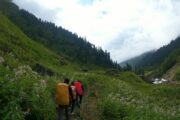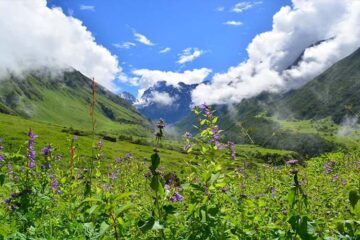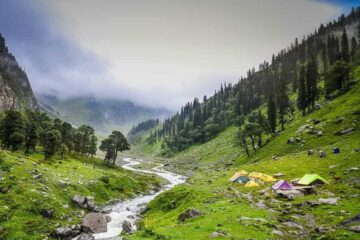The Ruinsara Lake Trek
Region :- Uttarakhand
Snow: December to March
Ruinsara Lake (3500M), a clean water lake, is at the foot of Mt. Kalanag and is situated 14 km from Osla/Seema. Ruinsara Lake is another appealing area for trekkers within the Uttarkashi district of Uttarakhand. The lake is surrounded by Alpine Pastures and occasional Rhododendrons and is taken into consideration as sacred by the population of the Har-Ki-Doon Valley. The lake is close to the supply of Supin river. From right here, one receives nearer perspectives of Mt. Kalanag, the Ruinsar range, BandarPoonch, and Swargarohini peaks, which might be superb. Located simply under the Bandarpoonch Glacier, the lake is a really perfect tenting site.
Ruinsara Tal is a high-altitude lake, in the Garhwal region of Uttarakhand—and is known for its sublime scenes, complete with snow-crested peaks, lush green meadows, rocky paths, and gushing waters. You can trek to this gorgeous lake: a moderate hike of about 64kms, that will take you through the most breathtaking trails and vistas. Panorama that covers the core of G.B.Pant National Park.
The journey can take up to 7 days, and may seem arduous to some, so come prepared.The trek to Ruinsara Lake is a beautiful trek through the Govind National Park (gangotri), which is famous for its wild flowers especially orchids.A holy lake present in Govind Wildlife Sanctuary of Uttarkashi district at an elevation of 3500 meters.Ruinsara Lake is famous for its green grasslands, alpine vegetation and Rhododendrons, surrounded by tall standing peaks and offers majestic views of pristine mountains.
Ruinsara Lake Trek, Uttarkashi, Uttarakhand
Day 1- Dehradun - Sankri
Day 2- Sankri (Base Camp) to Cheludgad (Seema) via Taluka
Day 3- Seema to Devsu bugyal
Day 4- Devsu bugyal to Ruinsara Lake
Day 5- Ruinsara Lake to Devsu bugyal
Day 6- Devsu bugyal to Sankri via Taluka
Day 7- Sankri (Base Camp) to Dehradun
Day 1- Dehradun - Sankri
Assemble at the Dehradun Railway station with the aid of 6.30 AM. Our adventure starts as quickly as we hit the streets of Dehradun. A long but fun drive, whereby we continue to Kempty Falls, close to Mussoorie, to revel in a hearty breakfast. While our adventure resumes, you may respect the corporation and the lovable perspectives of the serpentine river Tons. Smell the clean air at the same time as admiring the leaves of the several pine trees swaying in the breeze as we byskip with the aid of Purola.
Driving with the aid of using an area referred to as Mori, nearing toward Sankri, you may get a glimpse of the river Tons becoming a member of a glacial move to end up the river Supin. Before we attain Sankri, the remaining 22kms passes thru the Govind National Park in which one can be fortunate sufficient to identify a few wildlife. So preserve your eyes peeled! As we technique Sankri at about 6 pm, you’ll be capable of glimpse this old fashioned and quiet village that’s now a hive of interest because of the hiking season.
Day 2- Sankri (Base Camp) to Cheludgad (Seema) via Taluka
Today you shall trek to Seema. You shall cross the Siyan Gad with the aid of a bridge to attain Dhatmir village. Later, you’ll byskip the river in the direction of the proper facet of the Tons river. You will be treated to breathtaking views of lush inexperienced flowers, wild orchids, and, if you are lucky, encounters with Himalayan flora and fauna such as barking deer, bore, leopard, and so on.
You’ll arrive at Seema in the late afternoon, and many of you will have the unique experience of spending your first night out beneath the stars in the tents… Bonfire snacks and possibly a few folklore and spooky stories will keep you occupied for the remainder of the night before you enjoy a lovely and warm freshly cooked dinner earlier than retiring to your slumbering cocoons with a plethora of unexplored goals in your eyes.
Day 3- Seema to Devsu bugyal
The trek to Devsu Bugyal begins with a slow ascent that provides spectacular views of snow-covered mountains and vast valleys with cascading waterfalls. The place is home to a few uncommon species of Himalayan birds and animals and is completely birch and spruce. After the last steep climb, the Devsu Bugyal campsite appears. Overnight, we live in tents.
Day 4- Devsu bugyal to Ruinsara Lake
Ruinsara Tal is through terraced mountain fields, lush inexperienced grassy lands, and conifer forests through an extraordinarily scenic landscape. The gradient of the trek is moderate, and one can be in a position to finish the trek in 5–6 hrs on arrival at the lake set campsite. The path leads through blended woodland and meadows of forget-me-nots and buttercups. Halfway to the lake, the valley widens and crosses a chain of flowered pastures wherein shepherds from the nearby villages graze their flocks in the summer.
Ruinsara Lake is taken into consideration as sacred by means of the encircling communities. It is located on the proper side of the main valley, surrounded by alpine pastures and a few rhododendrons beneath the magnificent Swargarohini Range Camp. Dinner and in a single day, living in tents.
Day 5- Ruinsara Lake to Devsu bugyal
After breakfast, continue right all the way down to camp at Dev Thach.
Day 6- Devsu bugyal to Sankri via Taluka
After breakfast, we can begin the trek to Taluka. Reach taluka with the aid of your afternoon. Drive from Taluka to Sankri. Overnight stay in Sankri.
Day 7- Sankri (Base Camp) to Dehradun
As we get ready to depart this splendidly tranquil and divine region, we take our luggage with a heavy heart and say our very last goodbyes over a healthy breakfast. Proceed to test out of the lodge with the aid of using eight am, in which case your transport, a Tata Sumo, or similar, awaits you.
As we journey lower back to Dehradun, treasure the never-ending vistas that lie all around you, even as you take the remaining minute photos. The approximately 10-hour adventure will keep you curious about limitless recollections to take lower back and share with your loved ones. We have ensured that the trek is in such a manner that you have been furnished with adequate relaxation to make it an exciting experience. Once in Dehradun, component methods together with your fellow trekkers, with the promise of experiencing every other interesting journey with us.
By Air:-
Dehradun’s Jolly Grant Airport is located about 20 km from the city. You will find a daily flight from Delhi to Dehradun.
Taking the train:
Take the overnight train to Dehradun from Delhi.
- Nandadevi Express-Departure at 11:50pm; Arrival at 5:40am
- Dehradun Express-Departure-9:10pm; Arrival-5:00am
By Bus:-
From Delhi’s ISBT Kashmere Gate, a regular bus service from Delhi to Dehradun is available.
Includes
- Meals during the trek
- Dinner on arrival day in Sankri.
- Forest Permits/Camping Charges (only if availing transportation through A1 Himalayas). Only up to the amount charged for Indian Nationals is included.
- Tents, sleeping bags, mats
- Safety equipment includes static rescue rope, seat harness, carabiners, pulleys,
- Trek guide, cook, helpers, porters, & mules for carrying common luggage.
- The Services of a Certified Trek Leader
Excludes
- Meals during road journeys
- Transportation from Dehradun to Sankri and back to Dehradun.
- Carriage of personal bags during the trek
- Any kind of insurance
- Any expense of a personal nature.
- Any expense not specified in the inclusion list
1) Trekking Shoe/Snow Shoe
2) Rucksack/Back Pack
3) Rucksack cover (Waterproof)
4) Daypack/Knapsack
5) Undergarments/Innerwear
6)Woolen socks
7) Woolen gloves
8) Waterproof gloves
9) T-shirt
10) Trek pants
11) Camp sandal
12) Balaclava/Woolen skull
cap/Monkey Cap
13) Sun cap/Wide-brimmed
Hat/Bandana
14) Walking Sticks/Trekking
Poles/Ski Poles
15) Heavy Jacket
16) Windproof Jacket/Wind
Cheater
17)Raingear/Poncho/Waterproof clothing
18) Water bottle/Hydration pack
19) Sunscreen lotion
20) Sunglasses
21) ChapStick/Cold &
Moisturizing cream
22) Toothbrush and toothpaste
23) Towel
24) Hand sanitizer
25) Tissue roll ( Toilet)
26) Anti Fungal Powder
27) Torch/Head Lamp with extra batteries
28) Knee cap
29) Camera with extra cells
30) Dry food items
31) Personal first-aid kit
32) Medicines (This is a simple
guide line and a doctor’s
consultation is recommended.)
Altitude is a risk. Before you begin the trek, you should be aware of the effects of high altitude on your body. Acute Mountain Sickness (AMS) symptoms include a moderate headache, nausea, and overall discomfort.
Reponse: If you have any of these symptoms, notify the trek leader immediately and follow his advice. To deal with the scenario, each campsite contains a stretcher, a fully prepared first aid kit, and oxygen cylinders.
Weather Risk : No one can guarantee snow, rain, or sunlight, even if we keep a constant eye on the weather. Please keep in mind that your safety is our primary priority, and if the weather isn’t cooperating, we won’t leave the campsite.
Response: The choice to go or wait for better weather will be made solely by the Trek Leaders and Guides.
Risk: Injury is a possibility. While trekking across difficult terrains, minor injuries such as calf sprains, bruising, and other minor ailments are prevalent. Serious injuries, such as fractures or significant cuts, are quite uncommon.
Response: All of our Trek Leaders are trained in wilderness first aid. They’ve been taught to deal with emergencies and have a well-stocked first-aid equipment to deal with minor injuries. In the event of major injuries, the patient is carried to the nearest road-head on a stretcher and taken to the nearest medical facility.
DO’S AND DON’TS ON A TREK
1. Alcohols or any other intoxicating products ‘’STRICTLY PROHIBHITED’’
during the trek.
2. Always pay heed to the trek guides or instructors.
3. Try not to leave the group under any circumstances.
4. Avoid trekking during the nights as it is extremely dangerous.
5. Avoid using earphones as that might hinder your hearing.
6. Do not participate or encourage littering of the places in any form.
7. While visiting the local villages and tourist sites, obey the local guidelines
and instructions.
8. Do not harm or interrupt the local sentiments of the places.
IMPORTANT:
Your safety is of paramount concern while traveling with A1 Himalayas.
Please note that your leader has the authority to amend or cancel any part of
the itinerary if it is deemed necessary due to safety concerns. Since adventure
entails traveling in remote mountainous regions, we cannot guarantee that we
will not deviate from it. Weather conditions, health condition of a group
member, unexpected natural disasters, etc., can all contribute to changes in
the itinerary. The leader will try to ensure that the trip runs according to plan,
but please be prepared to be flexible if required.











